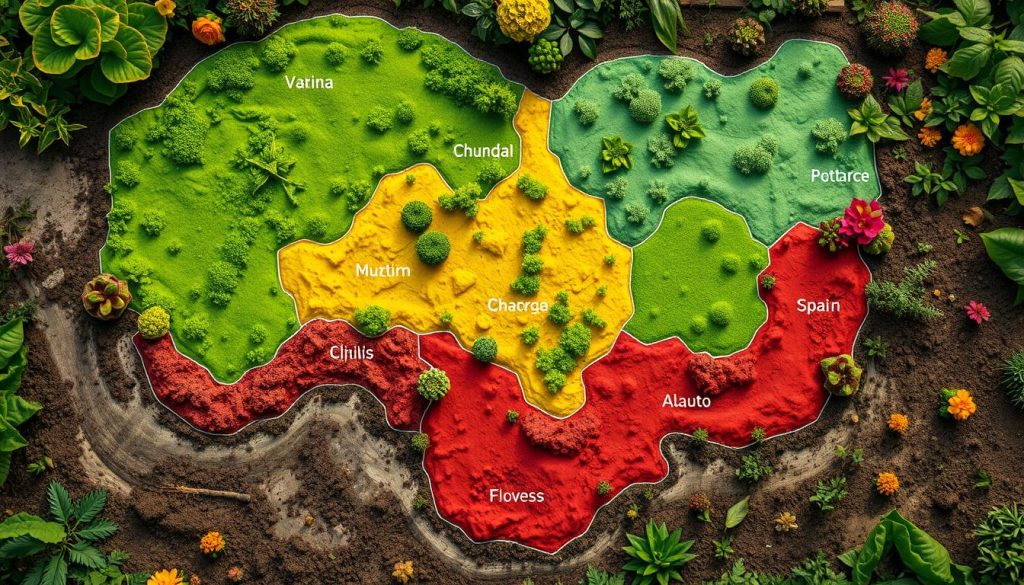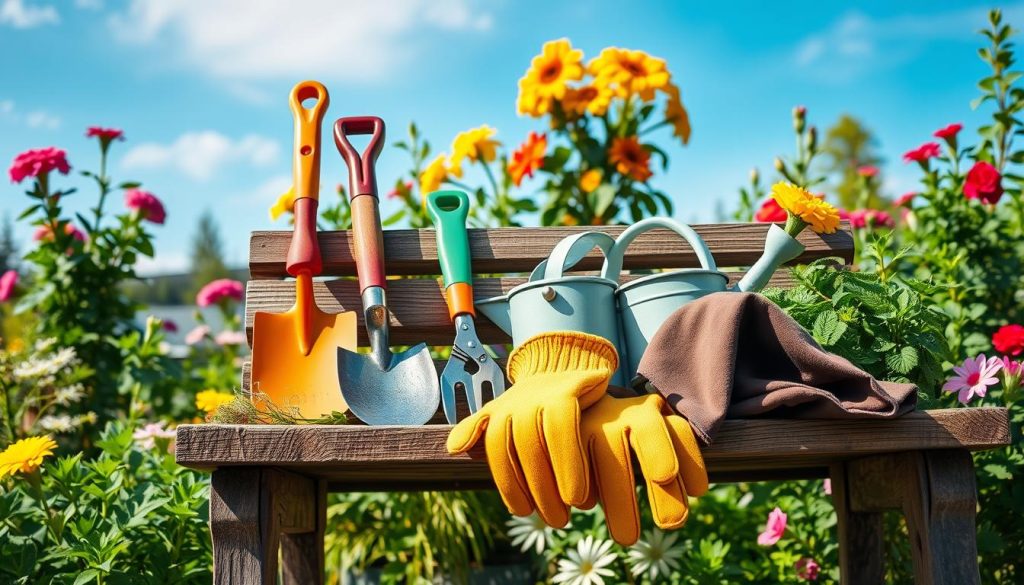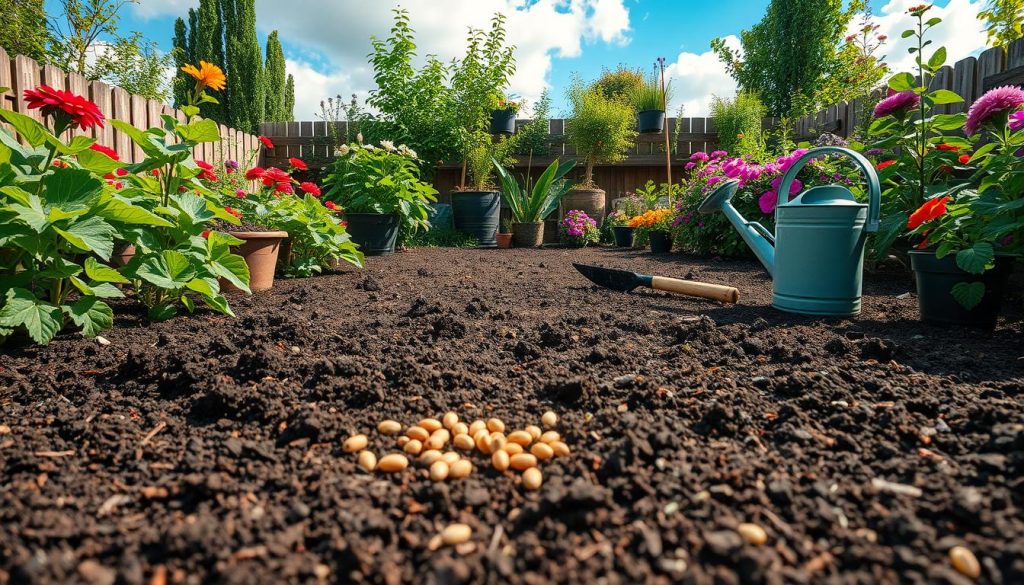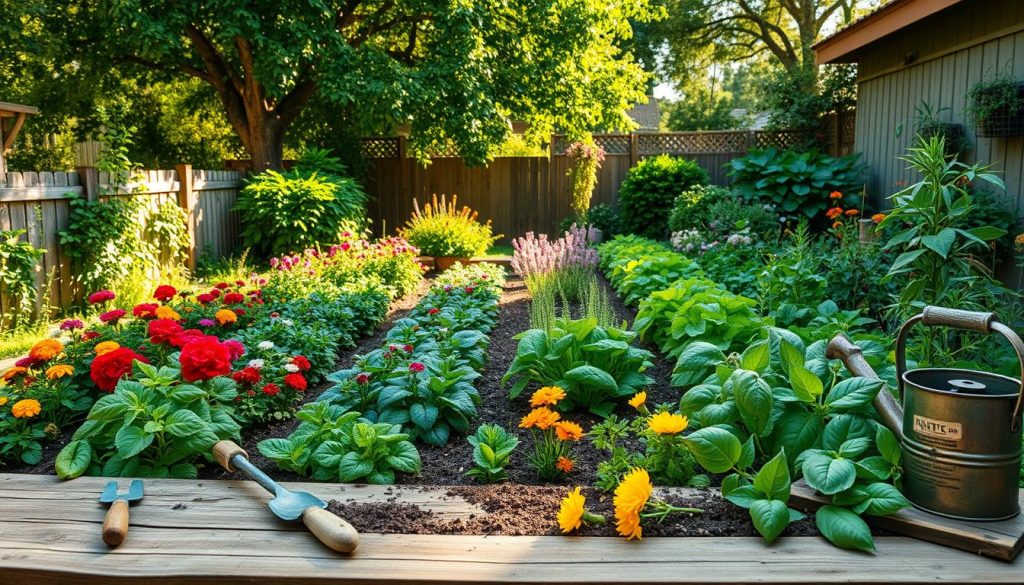I’m excited to share my knowledge with you and help you start your gardening journey. As a beginner, it can feel overwhelming. But with the right tips, you’ll grow a healthy and beautiful garden.
These tips will help you turn your backyard into a thriving garden, no matter the size. You’ll learn the essential steps to succeed in gardening.
In this article, I’ll share my expertise. You’ll learn how to choose the right plants, prepare your soil, and keep your garden healthy. Let’s start and grow a healthy backyard together!
Understanding Your Gardening Zone
Starting my gardening journey, I learned how key knowing my gardening zone is. It tells me which plants will do well in my area and when to plant them. By using these tips, I can make a garden that’s full of life and beauty.
To start, I need to figure out my gardening zone. I can use the USDA Plant Hardiness Zone Map or ask a local nursery. Knowing my zone lets me pick the best plants for my garden. Gardening tips for beginners say to choose plants that are native or have similar needs.

- Climate and temperature
- Soil type and quality
- Amount of sunlight and shade
- Watering requirements
By thinking about these things and following the tips, I can have a garden that’s easy to care for. Gardening can be fun, and with these tips, I can enjoy watching my plants grow.
Essential Gardening Tools for Beginners
Starting your gardening journey? The right tools are key to a thriving garden. They help you follow easy tips and keep your garden looking great. Let’s look at the essential tools every beginner should have.
Begin with a basic set of tools for various tasks. You’ll need gloves, pruning shears, a trowel, and a watering can. These tools make tasks like planting, watering, and pruning easier. They help you enjoy gardening more.
Must-Have Tools
- Gloves: to protect your hands from thorns and dirt
- Pruning shears: to trim and shape plants
- Trowel: to dig and plant seeds
- Watering can: to water plants efficiently
With these tools, you can easily follow simple tips. This makes gardening more fun and rewarding. Always take care of your tools to make them last longer.

Preparing Your Garden Soil
As a beginner gardener, preparing your garden soil is key to a healthy garden. By following some tips, you can make your soil rich in nutrients. I’ll show you how to test your soil and add organic matter to improve it.
Testing your soil quality is essential. It tells you about the pH level and nutrient content. You can buy a soil testing kit or send a sample to a lab. This way, you can adjust your soil to be perfect for your plants.
When testing your soil, consider a few things:
- pH level
- Nutrient content (nitrogen, phosphorus, potassium)
- Soil texture (clay, silt, sand)
Testing Soil Quality
After knowing your soil’s quality, you can start making it better. You might add compost or manure to boost nutrients and drainage.
Adding Organic Matter
Adding organic matter is a great way to improve your soil. You can use compost, manure, or peat moss. These tips will help you grow a healthy garden with plenty of harvests.

| Soil Type | pH Level | Nutrient Content |
|---|---|---|
| Clay | 6.0-7.0 | High in nutrients |
| Silt | 6.5-7.5 | Medium in nutrients |
| Sand | 7.0-8.0 | Low in nutrients |
Choosing Plants for My Garden
Choosing the right plants is key when starting a garden. With many options, it can feel overwhelming, especially for beginners. Follow some tips to create a beautiful garden that fits your climate and soil.
First, understand the difference between annuals and perennials. Annuals live for one year, while perennials come back every year. Here’s what you need to know:
- Annuals: They add color and texture right away but need replanting each year.
- Perennials: They return year after year but might need more care.
Annuals vs. Perennials
Think about your climate, soil, and how much time you can spend on your garden. If you want something easy, perennials might be better.
Native Plants Benefits
Native plants are great for beginners. They fit well with local climate and soil. They need less care and attract bees and butterflies. Here are some benefits:
- They need little maintenance and care.
- They attract local wildlife.
- They improve soil health.
Native plants help create a thriving garden ecosystem. Follow some tips to make your garden a success.

Understanding Sunlight Requirements
As a gardener, knowing what sunlight your plants need is key. This knowledge helps your garden grow strong and healthy. Follow simple tips to ensure your plants get the sunlight they need.
Full Sun vs. Partial Shade
Most plants need full sun or partial shade to grow well. Full sun means they need direct sunlight for at least 6 hours a day. Partial shade means they need 4-6 hours of indirect sunlight. Knowing this helps you pick the right plants for your garden.
Sunlight Considerations
When planting, think about these things:
- Plant type: Different plants need different amounts of sunlight. For example, veggies and flowers need full sun, while ferns and peace lilies prefer partial shade.
- Climate: In hot and sunny places, you might need to give your plants more shade to prevent burning.
- Soil type: The type of soil can also affect how much sunlight a plant needs. Plants in well-draining soil might need more sunlight than those in moist soil.
By considering these points and following simple tips, you can create a beautiful garden. Your plants will thrive because they get the right amount of sunlight.
| Plant Type | Sunlight Requirement |
|---|---|
| Vegetables | Full sun |
| Flowers | Full sun |
| Ferns | Partial shade |
| Peace lilies | Partial shade |
Creating a Watering Schedule
As a beginner gardener, I’ve learned that watering is key. With the right tips, I can make a watering schedule for my plants. I need to know how much water they need, based on plant type, soil, and climate.
For example, plants in full sun need more water than those in shade. By considering these factors, I can tailor a watering schedule. This ensures my plants get the right amount of water. Gardening advice says to water deeply but not often, which helps plants grow strong.
The best times to water are early morning or evening. This lets plants absorb water all day, reducing waste. By following these tips, I can keep my plants healthy and growing well.
How Much Water Does My Garden Need?
- Check the soil moisture by inserting a finger into the soil up to the knuckle
- Water plants when the top inch of soil feels dry
- Use a rain gauge to measure rainfall and adjust the watering schedule accordingly
Best Time to Water
Watering at the right time is crucial to prevent waterlogged soil and root rot. By watering in the early morning or evening, I can ensure that my plants receive the right amount of water, and I can enjoy a healthy and thriving garden.
Effective Pest Control Techniques
As a gardener, I’ve learned that pests can be a big problem. It’s key to have good pest control methods. Natural pest control is safe for plants and the environment.
Effective natural pest control includes introducing beneficial insects and using neem oil. Good garden hygiene is also important. These tips help prevent pests and keep your garden healthy.
- Encourage beneficial insects, such as ladybugs and lacewings, which prey on common garden pests
- Use neem oil to control pests like whiteflies and aphids
- Remove weeds and debris, which can harbor pests and diseases
Knowing the signs of pest infestation is crucial. Look for holes in leaves, discoloration, or eggs and larvae. This way, you can act fast and protect your garden. With these tips, your garden will stay pest-free and healthy.
Natural Pest Control Options
There are many natural pest control options. Diatomaceous earth, insecticidal soap, and horticultural oil are some examples. Using these methods helps create a balanced garden ecosystem. This promotes healthy plant growth and reduces pest risks.
Signs of Pest Infestation
Identifying pest infestation signs is key to quick action. Some common signs include:
| Pest | Signs of Infestation |
|---|---|
| Aphids | Curled or distorted leaves, sticky substance on leaves |
| Whiteflies | Yellowing leaves, presence of eggs and larvae |
| Slugs and snails | Holes in leaves, slime trails on plants |
By following these tips and knowing pest signs, you can have a healthy garden. Your garden will be free from pests and diseases.
The Importance of Mulching
Mulching is key to a healthy garden. It’s vital for beginners to know its benefits. With these tips, your garden will look great and need less care.
Mulching keeps the soil moist, stops weeds, and controls temperature. It’s a simple way to boost your garden’s health.
Types of Mulch
- Organic mulch: made from natural materials like wood chips, bark, or leaves
- Inorganic mulch: made from synthetic materials like plastic or landscape fabric
How Mulching Helps My Garden
Mulching is a simple yet effective way to improve your garden’s health. By following these easy gardening tips for newbies and simple gardening tips, you can create a thriving garden that requires less maintenance. Remember to choose the right type of mulch for your garden and apply it correctly to reap the benefits of mulching.
Keeping My Garden Healthy
To keep my garden healthy, I need to do regular maintenance and adjust with the seasons. By following beginner gardening advice, my garden will flourish all year.
Regular Maintenance Tasks
Important tasks include watering, pruning, and fertilizing. Here are some tips to keep in mind:
- Water plants deeply but infrequently to encourage deep root growth
- Prune plants regularly to promote healthy growth and prevent disease
- Fertilize plants seasonally to provide essential nutrients
Seasonal Gardening Tips
As the seasons change, so do my gardening tasks. In spring, I plant new seeds and seedlings. In summer, I focus on watering and pruning. In fall, I harvest crops and prepare the soil for next season. In winter, I protect plants from frost and plan for the next season.
By following these tips, I can keep my garden healthy and thriving. Stay tuned for more gardening tips and advice to help you grow a beautiful garden.
Harvesting My Garden Produce
Walking through my garden fills me with pride. The fruits of my labor are ready to be enjoyed. Harvesting my garden produce is the most rewarding part of gardening. I’m excited to share my experience with you.
Timing is key when it comes to harvesting. Knowing when to pick your crops ensures they’re at their best. For beginner-friendly gardening tips, check the specific harvesting times for each plant variety. Some plants, like tomatoes, are ready when fully red. Others, like lettuce, are best when young and tender.
Proper Harvesting Techniques
To harvest correctly, follow these beginner-friendly gardening tips:
- Use sharp, clean tools to prevent damaging the plants or spreading disease
- Harvest in the morning, when the plants are at their highest water content
- Handle the crops gently to avoid bruising or damaging them
By following these tips, you’ll enjoy a bountiful harvest. Share your fresh produce with loved ones. Always check the specific harvesting requirements for each plant variety to get the best flavor and texture.
Continuing My Gardening Education
Gardening is a lifelong journey filled with constant learning and discovery. Even as your
easy gardening tips for newbies
and
simple gardening tips for novices
start to pay off, there’s always more to explore. By immersing yourself in gardening resources and communities, you can continue honing your skills. You’ll also stay up-to-date with the latest trends and techniques.
Resources and Communities
Look for gardening blogs, YouTube channels, and social media groups that align with your interests. These platforms often offer valuable insights, tips, and inspiration from experienced gardeners. Local nurseries and community gardens can also be great sources of knowledge.
They provide hands-on guidance and opportunities to connect with fellow green thumbs.
Experimenting and Learning
Don’t be afraid to try new things in your garden. Experiment with different plant varieties, gardening methods, and tools. This way, you’ll find what works best for your unique growing conditions.
By embracing a spirit of curiosity and a willingness to learn, you’ll continually expand your gardening expertise. You’ll find new joys in the process.
Remember, the journey of gardening is as rewarding as the destination. Stay curious, keep learning, and enjoy the ever-evolving beauty of your backyard oasis.

